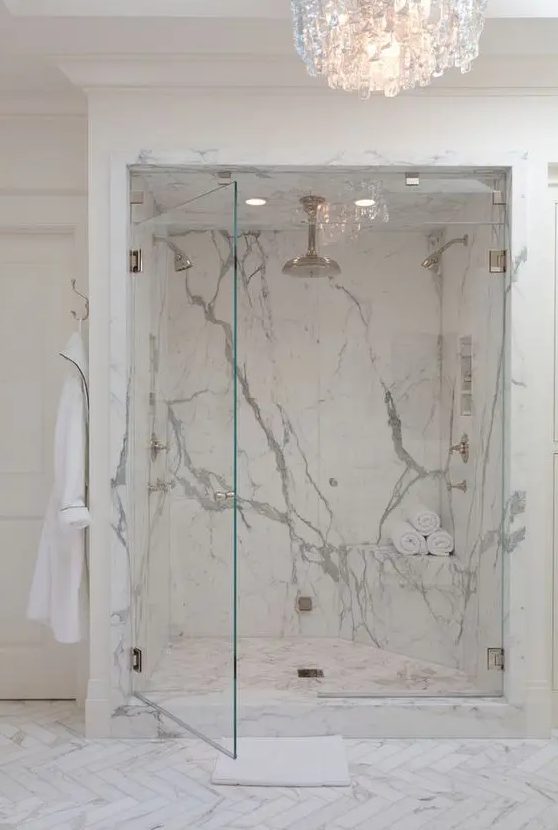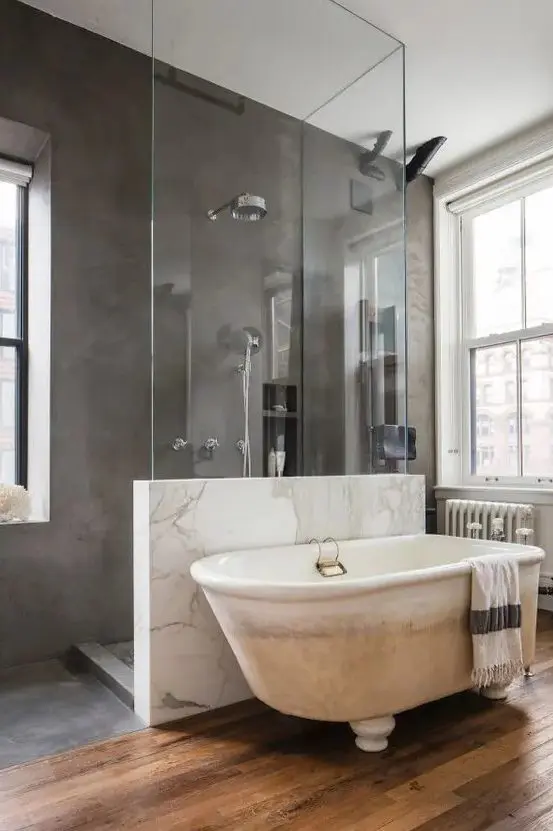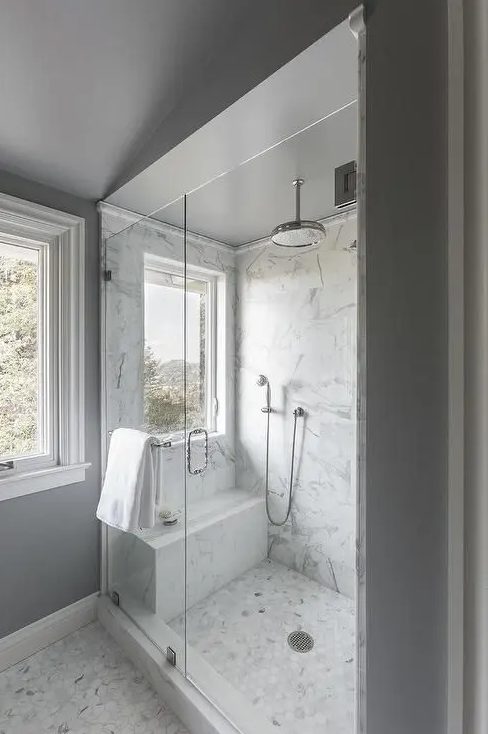Forget all those clawfoot tubs and stick to functionality with a walk-in shower! Being a hot trend in bathroom design, this type of shower also provides ease of access and safety. It eliminates the danger of stepping into a bathtub or an enclosed shower, which makes it a convenient and independent alternative for individuals with limited or impaired mobility. But besides having lots of advantages, walk-in showers feature some drawbacks, too. Let’s consider them all.
Pros Of Walk-In Showers
It is easy to clean a walk-in shower since most of the surfaces are flat and there are fewer corners or areas with less dirt or grime buildup. It takes less time to clean the glass walls and tiled floors as there are fewer crannies and nooks to scrub compared to a traditional shower enclosure.
A walk-in shower can be installed in any bathroom size, as it can be customized to suit your actual space. You will not have any difficulties putting up this type of shower in a room that might be limited in space or of an unusual shape.
Unlike bathtubs or shower enclosures, walk-in showers are more accessible and are a perfect solution for individuals with mobility challenges. They eliminate the need of stepping over a high ledge or tripping on a steep threshold while entering into the shower.
A walk-in shower is simple and straightforward because it has less moving parts with no doors or shower curtains. Since most models are made of glass walls with a frameless look, no elements can distract the attention from your bathroom décor making it more like a transparent feature.
A walk-in shower creates the illusion of a large space even though it can easily fit in tiny bathroom spaces. The shower itself becomes visible, as it is not blocked from view by a shower door. This settle footage is contributed to the entire bathroom doubling the view of your bathroom size.
A bathroom clad with penny tiles and with neutral tiles on the floor, brass fixtures and a clawfoot bathtub, a niche for storage.
A chic modern bathroom with a walk-in shower clad with white subway tiles, with a smart storage space with built-in shelves.
A contemporary bathroom clad with white skinny tiles, with a neutral vanity, a walk-in shower with black fixtures and a niche for storage.
A contemporary bathroom with large scale tiles, neutral appliances and a cool walk-in shower with a window and a glass door.
A contemporary bathroom with pink herringbone tiles and marble ones in the walk-in shower plus black fixtures.
A contemporary bathroom with white tiles, a wooden floor, a floating vanity, black fixtures and a glass door in the shower.
A contemporary neutral bathroom with skinny tiles and a terrazzo floor, a walk-in shower and brass fixtures for more elegance.
A large and chic walk-in shower clad with white and black and white tiles, with glass doors and vintage-inspired black fixtures.
A large walk-in shower space clad with white marble tiles, with a built-in shelf and bench and a wooden mat.
A lovely modern bathroom with white subway tiles and a pink geo tile floor, a walk-in shower with a glass partition, a stained wood desk.
A luxurious bathroom with a walk-in shower clad with white marble tiles and with glass door plus a refined crystal chandelier.
A luxurious modern white shower space with glass doors, white tiles and a terrazzo floor, a basket for storage and an orchid.
Cons of Walk-In Showers
A walk-in shower does not offer enough privacy, as it lacks a door while other designs are purely made of glass walls. It is not ideal for a commercial space where people share the bathroom as it could mean that only one person can use it at a time. However, people who incorporate a walk-in shower in their washroom have the freedom to customize their level of privacy.
You are more likely to feel a lot of cold in a walk-in shower as it lacks a door or a shower curtain. The air that relocates via the door-less entrance makes the room colder. However, you can solve this issue by installing a glowing warmed flooring or mounting a warmth light.
There is a high possibility of water splashing into the rest of the shower room depending on your shower design. You can minimize this issue by installing the right type of shower base and mindful planning. Water splashes can make your bathroom a mess and even increase the chances of fall if it is not taken care of.
Regardless of the design, water and moisture will eventually leave the shower in some form either as water splashes or as steam from hot showers. This can cause damage to the entire bathroom since high humidity and moisture creates a damp environment, which is a favorite recipe for mold.
The price of a walk-in shower can be a major disadvantage to homeowners looking for a minimalistic design. Although it might look simple and straightforward in appearance, it is made up of high-quality glass and complex hidden drainage systems that make it expensive compared to traditional designs.
A walk-in shower is a great focal piece in a bathroom that blends seamlessly with the rest of the space. While it comes with a few downsides, you can minimize its flaws by installing the right showerhead, a non-slippery flooring, and install the drain in a strategic position. Having it installed by a professional is a good idea, as you not only benefit from the aesthetics but also its functionality in an accessible bathroom.
A minimalist bathroom with a spa feel, with a walk-in shower with a wooden floor, a skylight and a large vanity.
A minimalist bathroom with tan large-scale tiles, a walk-in shower with a glass partition, a wall-mounted sink.
A modern bathroom with a black herringbone floor, white subway tiles in the walk-in shower, with a glass paritition and a wooden bench.
A modern bathroom with concrete walls and a floor, with a half wall and glass partition in the shower, a vintage tub.
A modern bathroom with green paneling, a walk-in shower with concrete and a terrazzo wall, brass fixtures and a glass partition.
A modern bathroom with neutral and slate grey tiles in the walk-in shower, with black fixtures and some greenery.
A modern walk-in shower clad with wood-like tiles, with a tiled floor, a built-in bench and niches for storage plus a skylight.
A neutral bathroom with grey walls, a white marble tile floor, a white marble shower space and penny tiles on the floor.
A pretty contemporary bathroom with white and black and white tiles, with white appliances, a walk-in shower and brass touches.
A refined and chic walk-in shower clad with white marble, with a single glass space divider and a built-in seat is a very seel and modern idea.
A refined contemporary bathroom with neutral tiles and a marble floor, niche shelves and neutral fixtures.
A spa-inspired wlak-in shower with wooden slabs covering the floor and the bench, with a rain shower and an orchid.
A stylish modern bathroom with large scale hexagon tiles, a concrete wall-mounted sink, a walk-in shower with a glass partition.
A unique bathroom clad with aged metal tiles, with a shower space with a penny tile floor and glass doors, a chic bathtub and penny tile accents.
An East-inspired walk-in shower with a wooden floor, stone-like tiles and a rain shower for a real spa-like feel.
An ultra-minimalist bathroom clad with concrete, with a black shelf and shower and a glass partition that is seamless.






























